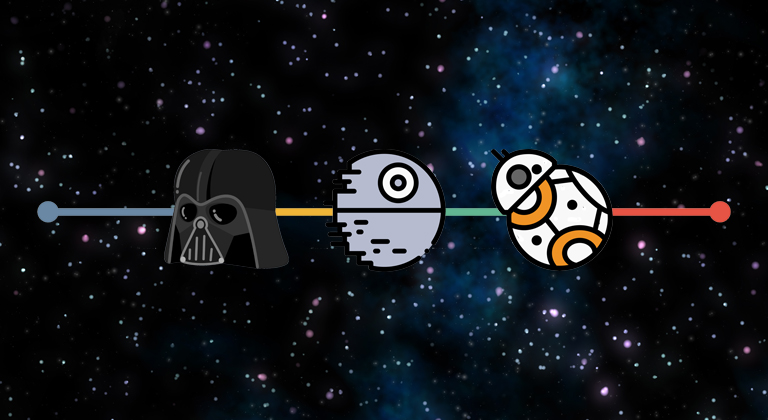How to craft prequels the Star Wars way
The Star Wars prequels have long been a topic of debate among fans and critics alike, but it’s hard to argue against their success in expanding the beloved fictional universe into something even bigger and grander in scale. There are many reasons for creating a prequel, from adding depth to an existing story to offering fresh perspectives that create stronger connections with well-known characters.
Numerous prequels have enriched their original series, and when done well, they are usually appreciated by fans eager to return to a world filled with familiar characters and settings. For authors, prequels provide the opportunity to build rich new backstories for their characters and enhance their fictional worlds, as long as they maintain continuity with the original works. In today’s blog, Ginger uses the Star Wars universe, and many other examples from film and literature, to illustrate how you, too, can use prequels to captivate your audience and add significant value to your overarching story.
Last year, my 12-year-old son dressed up in a homemade Boba Fett costume and I took him to FAN EXPO Philadelphia to meet Hayden Christensen, the actor most famous for playing Anakin Skywalker in the Star Wars prequel trilogy.
My son was so excited! As responsible parents, my wife and I had introduced all our kids to the original Star Wars movies at an early age but it was only my 12-year old who wanted to explore the rest of the movie series. (My other kids’ lack of faith disturbed me.)
But explore them my 12-year-old did! He watched all of the Clone Wars series, read the original trilogy of Boba Fett novels, and absolutely fell in love with the third of the prequel movies, Revenge of the Sith. In fact, the running joke in our family is that the correct viewing order of the first six Star Wars movies is:
- Revenge of the Sith
- Revenge of the Sith
- Revenge of the Sith
- Revenge of the Sith
- Revenge of the Sith
- Revenge of the Sith
I found it pretty heartwarming to see the love of Star Wars light up in his eyes, just like it had for me when I’d gone to see Return of the Jedi at the cinemas in the 1980s. What surprised me, however, was that it was the prequel movies that had truly captured his imagination, not the original three I’d grown up with.
Back when the prequel trilogy originally came out, many Star Wars purists hated them! They criticized the bad CGI, and the over-reliance on greenscreen technology, and the wooden acting of many of the cast. They complained that the script was badly written, and that too many of the cameos (like Chewbacca, in the third movie) were inauthentic “fan service.”
But twenty years later, as the generation who knew these as the flagship Star Wars grew up, opinions about the prequel trilogy have shifted. Now, they’re practically as beloved as the original trilogy of movies, and have spawned a whole universe of live-action, animated, and playable tie-ins. You only need to look at the impact of the recent Obi-Wan Kenobi show to see how powerful nostalgia is surrounding the prequels.
But for those who love fantasy and science fiction books as much as they love the Star Wars movies, the appeal should be fairly obvious. The allure of revisiting a beloved world and exploring its history is a powerful pull for both readers and writers. As an author, prequels offer a unique opportunity to expand the fictional universe you’ve created, deepen character relationships within it, and enrich a narrative you’ve already woven.
But crafting a successful prequel requires strategic planning and a keen eye for continuity – and to demonstrate that, let’s take a trip back to that Galaxy Far, Far Away and examine how the Star Wars prequels managed to pull it off.
- Fulfilling Prophecies: The prequels detail the rise of Anakin Skywalker, fulfilling the prophecy of the Chosen One hinted at in the original trilogy. This creates a sense of inevitability while adding layers of tragedy to his eventual fall.
- World-Building Through Technology: The prequels showcase the sleek, pristine aesthetics of the Republic’s technology, contrasting with the worn-down equipment of the Rebellion in the original films. This evolution visually reinforces the galaxy’s descent into war.
- Lightsaber Duels with Significance: The prequels showcase iconic lightsaber battles between Obi-Wan Kenobi and Qui-Gon Jinn against Darth Maul, and later, Obi-Wan Kenobi against Anakin Skywalker. These duels not only provide thrilling action sequences but also foreshadow the epic duel between Luke Skywalker and Darth Vader in the original trilogy.
Popular Prequels: Techniques in Action
Beyond a galaxy far, far away, numerous successful prequels demonstrate the power of well-crafted references and continuity. Here are a few examples:
- The Mistborn Era (Brandon Sanderson): This prequel series delves into the events that shaped the world of the original Mistborn trilogy. Sanderson references locations and magic systems established in the original series while focusing on a new generation of heroes and villains. These prequels explore the origins of the Lord Ruler, a central antagonist in the original trilogy, adding depth and complexity to his character.
- The ACOTAR Prequel Novella (Sarah J. Maas): This prequel novella explores the backstory of Rhysand, a key character in the A Court of Thorns and Roses series. Maas subtly references events and characters from the original series, such as the war with Hybern, while providing a deeper understanding of Rhysand’s past and motivations.
- Throne of Glass Series: Queen of Shadows (Sarah J. Maas): Though not a full prequel, this novel within the Throne of Glass series delves deep into the backstory of the powerful witch Celaena Sardothien. This exploration of Celaena’s past sheds light on her relationship with the series’ main protagonist, Aelin Ashryver Galathynius, and foreshadows future events in the series.
- The Hunger Games Trilogy Prequel (Suzanne Collins): This novel explores the events leading up to the brutal games of the original trilogy. Collins references past victors mentioned in the original books, like Haymitch Abernathy, and offers glimpses of the societal tensions that ultimately fuel the games.
- The Godfather Part II (Mario Puzo): This prequel seamlessly interweaves the rise of Vito Corleone with the struggles of Michael Corleone in the present. Flashbacks to Vito’s early life showcase the origins of the Corleone family’s power base and offer a deeper understanding of Michael’s choices.
- The Grishaverse Series: Six of Crows (Leigh Bardugo): This prequel explores a daring heist set within the magical world of the Grisha trilogy. Bardugo creates a compelling standalone story while referencing established characters and magical systems, rewarding readers familiar with the original series with subtle hints and foreshadowing.
Tips for Crafting Your Own Prequel
- Identify Your “Why?”: Is your goal to explore character development, offer backstory to a major event, or introduce a threat that later impacts the original series? A clear purpose will guide your narrative direction.
- Maintain Continuity: Ensure your prequel doesn’t contradict established facts or timelines in your original work. Reference details subtly, like familiar locations, character quirks, or historical events mentioned in your original series.
- Focus on a New Story: While references connect the prequel to the original, your prequel should offer a fresh story with its own conflict and stakes. Don’t simply retell familiar events.
- Plant Seeds for the Future: Prequels offer opportunities for foreshadowing. Plant seeds of future events or leave certain character motivations ambiguous to pique reader interest and encourage revisiting the original work.
- Consider the Tone: While maintaining consistency with your world-building, consider if the tone of your prequel needs to be adjusted to fit the chosen timeframe. Was your original series a lighthearted adventure? A dark and gritty thriller?
Ultimately, the Star Wars prequels proved that a successful prequel is not only about providing fan service for existing readers. It’s about enriching your universe in new and compelling ways, and offering readers a deeper emotional connection to the characters and world of your original stories. The prequel trilogy seeks to bring balance to the Star Wars universe, just as the prophecy of the Chosen One sought to bring balance to the Force. Those movies succeed by balancing careful reference to the original movies, whilst also crafting a compelling new story that reaches a brand-new audience.











